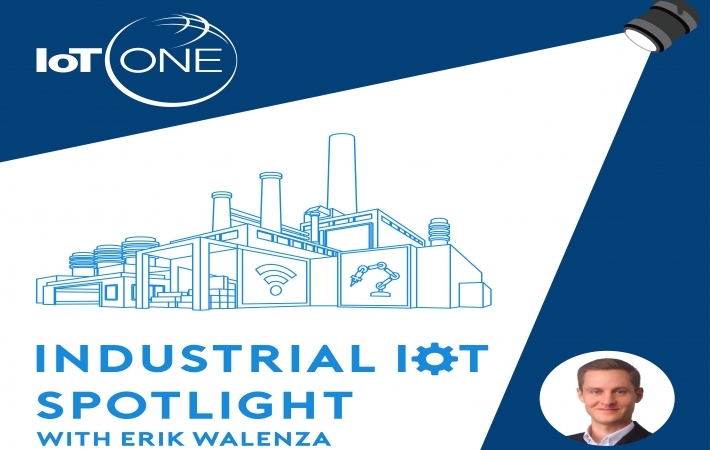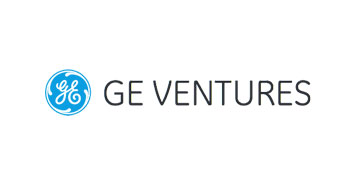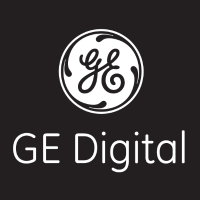
Published on 11/27/2017 | IoT Index
This is an episode of the "Ventures in Industrial IoT" series brought to you by GE Ventures. In the series we explore success factors and challenges in Industrial IoT markets with CEOs, investors and experts.

IoT Spotlight Podcast introduction:
The IIoT Spotlight Podcast shines a light on Industrial IoT solutions that are impacting businesses today. Every episode we interview an expert about a specific IoT use case. Our goal is to provide insight into the planning and implementation of IIoT systems, from new business models to technology architecture selection to data ownership and security. The IIoT Spotlight is produced by IoT ONE, an information platform that provides market insight, partner development, and go-to-market support for technology providers, end users, and investors. Don't forget to follow us on twitter. You can contact me directly at erik.walenza@iotone.com.
Summary:
According to the 2017 Gartner Hype Cycle for Emerging Technologies, many emerging technologies linked to IoT like machine learning, cognitive computing and IoT platforms find themselves in the "peak of inflated expectations" phase. At such an inflexion point, it is vital to accurately evaluate the promise these technologies hold for us.
In the first part of the very first episode of this exciting new series, Mike Dolbec, Managing Director of venture investments and M&A at GE Digital has a candid discussion with Erik about edge computing, blockchain and other nascent technologies in the Industrial IoT space. Learn more: www.geventures.com
Links to podcast:
Libsyn: http://directory.libsyn.com/episode/index/id/6007372
iTunes: https://itunes.apple.com/us/podcast/industrial-iot-spotlight/id1228185407?mt=2
Speaker bio:

Michael Dolbec is the Managing Director of Digital Strategy, Venture Investments and M&A at GE Digital. He is also an investor with Alchemist Accelerator and with i3 Equity Partners as well as a board observer on Foghorns Systems, DataTorrent, Mocana, MAANA and Ayasdi.
Michael is passionate about transforming big ideas into successful innovations, products and services. He develops partner eco-systems around technology platforms and helps companies grow via partnerships, investments and acquisitions.
Company Overview:

GE Digital is working with more than 10,000 software engineers across several of their business divisions to ensure that their customers in all sectors can tap into the power of the Industrial Internet. Their approach is built around a common software platform, agile development and shared services. By combining the nimbleness of a Silicon Valley startup with the strong pedigree of GE’s global expertise, GE Digital stands alone.
Blurbs:
“Edge computing is both hype and hot. It’s been hype for a long time but is now turning into reality and picking up steam.” – Michael Dolbec
“It’s [edge computing] surprised people who’ve had a cloud strategy exclusively.” – Michael Dolbec
“Many entrepreneurs are using blockchain to extend the capabilities of the network to the non-IP endpoints.” – Michael Dolbec
“We need solutions that are built for non-technical operators to make sense off” –Erik Walenza
“The rising tide of consumer expectations and experiences at home and elsewhere in the enterprise has washed over into the industrial space” – Michael Dolbec
“Thanks for making this possible. Now make it way more easy to use and valuable in terms of my productivity, don’t waste my time.” – Michael Dolbec
Show Transciption:
[00:00:12]
Hello I'm Erik Walenza founder of IoT ONE and this is the Industrial IoT spotlight. Every episode I interview one expert about a project that is impacting businesses today. Visit us at IoT one dot com to learn more. Or email me to start a discussion.
[00:00:32]
Welcome back to the industrial spotlight. I'm joined today by Mike Dolbec. Mike is managing director of venture capital and M&A at GE Digital.
[00:00:41]
He is also an investor with Alchemist Accelerator. And with i3 Equity Partners as well as a board observer on Foghorns Systems, DataTorrent, Mocana, MAANA and Ayasdi we're very excited to have Mike here obviously he has a depth of experience in the space and we're going to be talking about three topics today. First what's hot versus what's hype in the Industrial IoT space. I believe we have a lot of technologies in companies that could be classified as either or both of those. Second, challenges and opportunities specifically from the adoption standpoint. And then finally looking at partnering beyond funding so how are companies like GE partnering with startups not just for venture funding but also for go-to-market, for support with strategic direction in R&D and in other aspects. We're going to break this podcast up into three parts as normal. We'll be publishing the first on a Monday, the second on a Wednesday and the third on a Friday so make sure you join us for all three.
[00:01:46]
Mike to kick off, give me an overview of the technologies that you think in the edge computing space that are most likely to radically change industries, potentially change the world in the coming five to 10 years.
[00:02:01]
Well first thank you for having me and letting me participate with your podcast. It's very cool. So I think Edge computing is much more of a trend now than it has ever been in the last 12 months. It's both hype and hot I suppose would be answer to your question. But it's been hype for a long time and now it's turning into reality and picking up steam and I'm assuming your audience has its own interpretation of what edge computing means. But the simplest one is computing that isn't happening centrally in the cloud and maybe is intelligently the work is until it should be split up and distributed and happens for good reasons where it should happen best.
[00:02:52]
Usually for economic and latency reasons.
[00:02:56]
So I think the thing that's rocking the world or is in the process of doing that right now it is as computing used to be a novelty kind of. Wouldnt it be great if that happened some day and now but at least as far as we can see our customers are extremely excited about the concept of not having to do everything in the cloud and they surprised us with how interested they were and things happening in a distributed way at a variety of places which collectively we call the edge. Most people may think about it as on the device or in the factory or but theres really a variety of edges. I think its surprised people who had strategies based on cloud computing exclusively or had just thought they convinced all their customers to trust cloud computing. Gosh now we have to turn around and have a new story but its really turned into a world where every company we meet and talk about potentially investing in or partnering, one of the very early questions is okay that's great that's wonderful strategy. What's your edge strategy what's your strategy to split the work as I described it so that efficiently parts that happen in a variety of places at the edge and then the rest of it maybe the heavy lifting happens centrally and I think that trend of entrepreneurs and large companies thinking through Okay what is our strategy and we no longer sell the one monolithic thing. We have to be smart about where the work happens and smart about thinking about how we split it and break it up. That's a huge trend. I think it's changing quite a few people's business plans.
[00:04:43]
And I think you're spot on that this caught a lot of companies off-guard. The focus had been on cloud and certainly cloud is going to be a very important aspect of the Industrial IoT a lot of heavy lifting is going to have to be done there.
[00:04:58]
But a lot of companies now for latency purposes and security and other reasons are looking now towards the edge. When you're looking at companies know I think from most people's perspective when we're looking at industrial IoT solutions, we're not looking at the infrastructure we're looking at the the SaaS aspect or the the application that you know a company might actually be engaging with but maybe the most important part is the actual the you know the piping the actual infrastructure that's making this possible where that wasn't possible a few years ago. What are the actual technology advances that are making edge now you know technically feasible cost-wise feasible or it just wasn't there a few years ago you know.
[00:05:38]
To me it feels like the capabilities have been in place for some time but I think the generic answer would be you know the typical computing power embedded systems are are now super capable and memory is almost free and bandwidth is a lot faster but still has an expensive price. The laws of physics are still in place so it still costs something to move from where you find it to where you wished it was and the cost of compute in cloud computing is very attractive and still falling rapidly. But it's still what it is. So I think it was almost as if the pieces had been in place for some time. It had been a mission that people knew was going to happen. And then a few people, a few early, innovative people started building an edge where we would think of as traditional edge gateways and showing demonstrating what's possible. Confirming the vision that many people have kind of saying yeah I told you so this is going to happen. I told you it was a good idea. And then it sort of snowballed after that. But we started telling our customers about this particular GE version of this vision four years ago. And like I said before we were overwhelmed by their response even though our version of it wasn't demonstrable until maybe three years ago two years ago two and a half years ago. But it's just it's like snowball right. Once you. Once it starts going and things start creating to it it picks up speed and it heads downhill pretty well. That's what it felt like to me. Wasn't that one breakthrough. I think it's just everybody coming together at just the right time and things set off on their own.
[00:07:28]
Yeah one of the interesting aspects of the Industrial IoT is certainly that the ecosystem play right which is that it's it's not one company with one killer app or new technological breakthrough that makes it possible it's it's ten different things that are all maturing and when they reach a point then the system becomes viable.
[00:07:45]
But let's look at a couple of specific technical technologies...
[00:07:50]
if I could interrupt you for just a minute...
please
[00:07:51]
The industrial world had a bit of a head start because they have a long history of machine-to-machine (M2M) networking so it was kind of the Jurassic period of edge computing unlike autonomous vehicles. I mean in our case there was no other way to get a vehicle to make its course correction in time before it hit something though edge computing was critically important. The end of the machine-to-machine phase of industrial computing has been going for decades and that gave us a head start in some cases it was difficult for some people to unlearn some lessons they had learned before. But a transition to edge computing was pretty smooth relative to some other industries.
[00:08:37]
So looking at a couple of technologies in specific blockchain. What do you feel is the potential for blockchain on the edge. You know there's a company called IOTA which is building and they call it the tangle not the black chain but the tangle that's specifically designed for machine-to-machine you know low-transaction costs or no transaction cost scalable communication. Other companies are also looking at applying blockchain in industrial settings. Do you see this as a significant opportunity do you think it's a concept that doesn't necessarily have kind of you know proof-of-concept or proofs in operations yet and we'll have to just see if this actually pans out as a viable technology.
[00:09:17]
Let's see. So I I'd say we're very excited about the prospect of what might be achieved because of blockchain extremely excited about the number of people trying...you know they're innovating they're trying to come up with a number of commercially significant uses of blockchain in IoT almost as many as there are in Fintech. The uses tend to be slightly different. They often revolve around identity, authentication, access control that kind of thing. And yet we're still in the very early innings of a long baseball game because I think our criteria are it has to be more than novel right? Just because you can do something in a novel way with blockchain doesn't mean that it's a commercially attractive investment. It just means it's different. So we place a pretty high bar on these things. It has to be better not just different. And so our investigations of blockchain often happens in this weird world where you can picture the the IP network is extensive and imagine the edge of the IP network is all the end points that have IP addresses. Well, in industrial there's stuff be on that edge or non-IP devices that are connected eventually to an IP network. And we can't use today's wealth of rich infrastructure to authenticate non-IP address that was not at least not easily. So that's one thing we've been engaging with a number of entrepreneurs on. that use blockchain to extend the capabilities of the network to kind of you have a policy for identifying and to make sure that the jet engine is still what it says it is but something that says it's a physical device.
[00:11:10]
It's even harder to verify that it's still what it says it is and it's not spoofing you when it's not an IP address. It's a small device.
[00:11:18]
One of the other novel issues we face which I didn't realize until an architect pointed it out to me is most people in the modern infrastructure use some sort of PKI (Public Key Infrastructure) to authenticate IP things. You know you have credentials and you say you're a computer and your company about this computer and it's OK for this computer to be on that network. Well we make devices that are like computers but they last longer than anybody's public key infrastructure is designed to last 20, 30, 35, 40 years. And so we are almost guaranteed that whatever method we use today to authenticate that that thing is OK and it's still the thing it's claiming to be. That thing physically outlives probably the you know like going through a DVD and then it's in a CD-ROM and so forth a number of generations and eventually you can't find the player that runs your stuff because it's just an aged out. So we have to think about situations where the infrastructure we use to identify and authenticate things is wholesale obsolete and somehow survives a very long lifetime problem. And we've seen some interesting uses of blockchain in that perspective as well either it lives a long time or its an easy way to come back to a thing and re-authenticate it. You have to go out of the field and re-identify it and make sure it's still good but you have to hook it up to a new authentication infrastructure at some point because we think that the ones we use today you know they won't last the 10 to 20 30 year cycle and we have for some products.
[00:12:54]
You know this lifecycle management. Excellent point I suppose with a high value asset like a jet engine.
[00:13:00]
You know maybe the cost can be borne for every five or ten years re-authenticating but for a lot of IoT devices you know the cost of the assets are low enough that it's just not going to be feasible to send people out and and manually do any work it's going to have to be an automated process.
[00:13:17]
And you don't usually worry about that because consumer products like your phone generally has a I don't know what it is now nine to 18 months maybe 24 month lifecycle before eventually you know that version of the operating system isn't supported anymore or the new version won't fit in your phone because there's not enough memory. So eventually they you know the end of life of those things is not 10 years not 20 years so forth. So these long life time very expensive exotic assets have unique requirements that nobody thought about when they were building today's public key infrastructure. At least I don't think they did so many not many of the assets have the problem but ours[Industrial IoT] do.
[00:14:00]
Mike what are a few companies that are the most exciting that you've had the chance to work with I think Foghorn,DataTorrent doing very interesting work in the edge. What other companies that you most enjoy or that you're most excited to watch as they mature over the coming years in this space.
[00:14:15]
We have an investment with Foghorn so I'd love to talk about them. They're a leader in analytics or edge computing and now machine learning. But the challenge is if you had edge computing as a resource at your disposal how do you make the effort to exploit it. A low bar so that people in factories and people who develop software for trains and jet engines and so forth can exploit it without needing to become super experts in exotic real-time programming languages. I think that's the the real breakthrough with Foghorn. They're ultimately making it accessible for a relatively talented but not Ph.D. employee to move things that were usually reserved for doing later. Why did scientists in the cloud move them all the way out to the edge. Maybe next to a device so that you arbitrage the either the cost of moving and storing the bits and or exploit the latency of being able to react. Notice something important has happened and then react to it pretty efficiently in a short amount of time. And those two things combined together. Most industrial situations like saving money and doing things fast and on time so people tend to respond to it. The other thing for me is Foghorn-we partner with them extensively, I think we have a great relationship where we can trade. I think more important than our investment in cash what's more important is us sharing our requirements for different customer use cases which has allowed them to kind of see into the future a little bit farther than other companies and now they're doing, I can't reveal everything but I think that they are now focusing on ease of use features that actually understand the lifecycle of what it's like for somebody to engage with the customer, deliver a solution, configure it set it up, maintain it over time and they're are starting to work on the whole life cycle issue. So it's probably the industrial equivalent of the out-of-box experience that consumer goods companies are really good at. So it's not just the phone and how you use the phone. In my analogy it's how easy is it to get a phone provision to the networks. So I think they're delighted they're in the age of growth where they can now learn enough from customers to start hitting the secondary and tertiary requirements that are discussed.
[00:16:53]
So I think you're spot on there are a lot of the heavy lifting in terms of the core technology development we seem to have, you know we seem to be there at least to provide value in a lot of spaces.
[00:17:05]
But when we talked to you know end users a lot of the barriers around their ability to implement these solutions or even to evaluate is the solution you know how do I compare two different solutions. How do I anticipate changes in technology and so forth. You know I'm based here in China and it's kind of a running joke that a lot of state owned enterprises. They might have $10 billion in revenue and 10000 employees but their Web sites look like they were from the late 1990s because they they're very engineering-heavy you know heavy on mechanical engineering heavy on electrical engineering. But their I.T. teams are relatively immature. A lot of the IT talent is sucked up by the Tencents and Alibabas so then you have all these traditional companies that are being faced with a lot of new technology that requires some degree of expertise on the IT side and they don't have the in-house teams and it's not I think generally reasonable to expect them to hire 100 Ph.D.s.
[00:18:08]
So we need to have solutions that are built for non-technical operators to make sense of.
[00:18:13]
You know our aesthetic for what's our attention span and our aesthetic for what's acceptable user experience is quite high thanks to excellent UX-s like the iPhone.
[00:18:25]
And it's spilled over into industrial. Believe me when you hire millennials into your companies to replace the old farts like me who maybe eventually retire. Their expectations for figuring out how to do something without a manual and repetitive tasks that would be much easier, the second or third time because it's learned what it is you want, just mentioning the number of different UX factors that navigation ought to resemble, it shouldn't be a whole lot worse than you know the amount of effort I'm willing to navigate through to get something done on the social network. It's a high bar and it's not something traditionally that industrial companies have invested in because they could force their employees to use whatever they developed. But I think now you know the rising tide of consumer expectations and experience at home and elsewhere in the enterprise is washed over. So yes something that each of our companies eventually has their customer feedback tasked with. Thanks for making this possible. Now make it way more easy to use and way more valuable in terms of my productivity. Don't waste my time.
[00:19:35]
And this is a great point to wrap up the first part of the discussion which is you know what's what's hot versus what's hype. We'll be discussing next, challenges and opportunities from the adoption standpoint.
[00:19:46]
This again will be published on the Wednesday following on the podcast that you're listening to today. So please look out for this coming podcast. Thanks again for joining.
[00:19:59]
Thanks for tuning into another edition of the Industrial IoT spotlight. Don't forget to follow us on Twitter @IotoneHQ and to check out our database of case studies on iotone.com. We help to accelerate digital transformation by advising business leaders on how to integrate IoT technologies into their operations and products. We appreciate your thoughts, suggestions and of course your reviews and if you have an interesting project we'd love to feature you on a future edition. You can write me at erik.walenza@iotone.com.